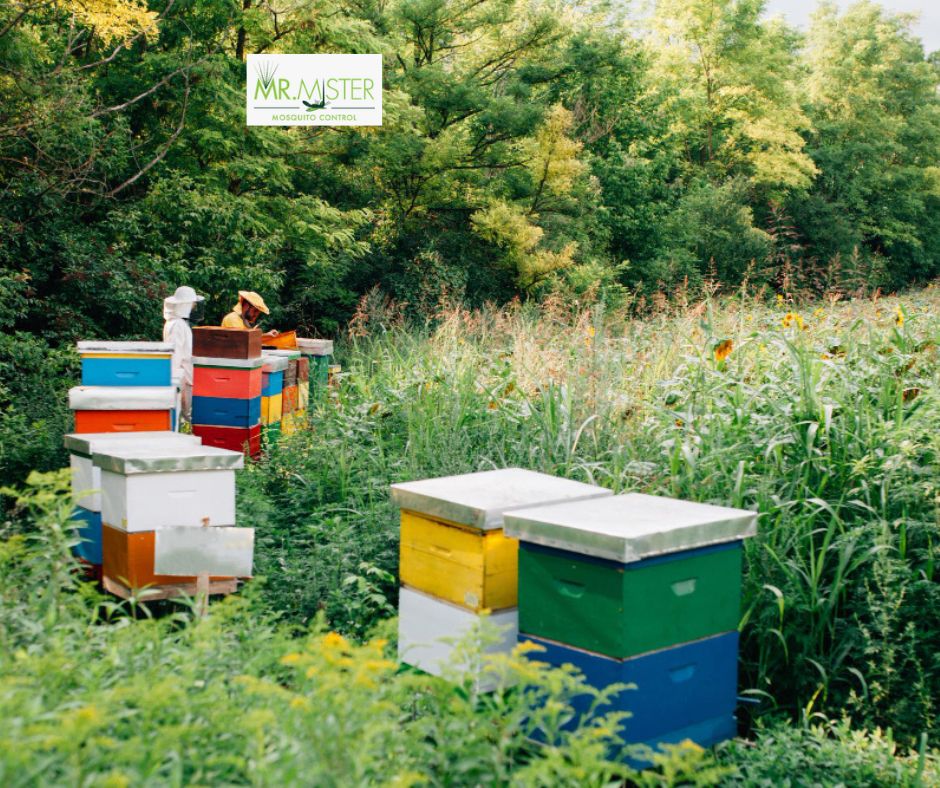Bee-Friendly Garden: Balancing Pollinators and Mosquito Control
Gardening isn’t just about beautifying your surroundings; it’s also about creating a harmonious ecosystem that supports various forms of life. One crucial aspect of this is attracting pollinators like bees while also managing pests like mosquitoes. In this article, we’ll explore planting strategies to achieve both objectives, creating a vibrant and balanced garden.
Understanding the Importance of Bees:
Bees play a vital role in pollination, facilitating the reproduction of many flowering plants, including fruits, vegetables, and nuts. With bees, our food supply would be significantly protected. Unfortunately, bee populations worldwide are declining due to habitat loss, pesticide use, disease, and climate change.
Creating a Bee-Friendly Garden
Choose Native Plants:
Native plants are adapted to the local climate and soil conditions, making them attractive to native bee species. Research which plants are native to your region and incorporate them into your garden. Examples include lavender, sunflowers, coneflowers, and wildflowers like black-eyed Susans and goldenrods.
Provide a Variety of Flowers:
Bees are attracted to a diverse range of flower shapes, sizes, and colors. Plant a variety of flowers that bloom at different times throughout the growing season to provide a continuous food source for bees.
Incorporate Herbs: Many herbs, such as thyme, rosemary, mint, and basil, produce flowers that attract bees. Plus, they can be harvested for culinary use, making them a practical addition to any garden.
Create Nesting Sites:
Bees need places to nest and lay their eggs. Leave patches of bare ground for ground-nesting bees and incorporate bee houses or bee hotels for solitary bee species. These can be made from materials like bamboo tubes or drilled wooden blocks.
Managing Mosquitoes
While attracting pollinators is essential, it’s also crucial to manage mosquitoes, especially in areas prone to mosquito-borne diseases like Zika and West Nile virus. Here are some strategies to keep mosquitoes at bay without harming beneficial insects:
Eliminate Standing Water:
Mosquitoes breed in stagnant water, so regularly emptying and cleaning bird baths, flower pots, and gutters can help reduce mosquito populations in your garden.
Use Mosquito-Repellent Plants: Certain plants naturally repel mosquitoes due to their scent or chemical properties. Examples include citronella, marigolds, lavender, and basil. Planting these around seating areas or near entrances to your home can help deter mosquitoes.
Install Fans:
Mosquitoes are weak fliers and are easily deterred by wind. Installing outdoor fans in your garden can create a breeze that makes it difficult for mosquitoes to fly and land on people.
Avoid Chemical Pesticides: Chemical pesticides not only harm mosquitoes but also kill beneficial insects like bees and butterflies. Instead, opt for natural mosquito control methods, such as mosquito dunks containing Bacillus thuringiensis (BT) or mosquito traps that use CO2 to attract and capture mosquitoes.
Provide Water Sources:
While eliminating standing water is crucial to prevent mosquito breeding, providing a clean water source for bees and other pollinators is also essential. Shallow dishes filled with clean water and pebbles for landing spots can serve as watering stations for thirsty bees.
Create Habitat Diversity
- In addition to flowering plants, incorporate a variety of habitats into your garden to support a diverse range of pollinators.
- Include areas of dense vegetation for nesting and shelter, as well as open spaces for foraging.
- Consider adding features like log piles, rock walls, and even small ponds to increase habitat diversity.
Practice Sustainable Gardening:
Avoid the use of synthetic fertilizers and pesticides, as these can harm both pollinators and other beneficial insects. Instead, use organic gardening methods such as composting, mulching, and companion planting to maintain soil health and control pests naturally.
Encourage Community Involvement:
Spread awareness about the importance of pollinators and sustainable gardening practices within your community. Organize workshops, garden tours, or seed swaps to inspire others to create bee-friendly gardens in their neighborhoods.
Monitor and Evaluate:
- Regularly monitor your garden to assess its effectiveness in attracting pollinators and managing mosquitoes.
- Keep track of which plants are most popular with bees and which mosquito control methods are most effective.
- Use this information to make adjustments and improvements over time.
Be Patient and observer:
Creating a bee-friendly garden requires time and patience. Observe the interactions between plants, pollinators, and other insects in your garden and allow nature to take its course. By fostering a balanced ecosystem, you’ll create a resilient and thriving garden that benefits both wildlife and humans alike.
Educate Yourself:
Continuously educate yourself about the specific needs of pollinators and the local ecosystem in your area. Attend workshops, read books, and consult with local experts to deepen your understanding of native plant species, beneficial insects, and ecological gardening practices.
Support Pollinator Conservation Efforts:
Get involved in local or national initiatives dedicated to pollinator conservation. Join organizations such as the Xerces Society for Invertebrate Conservation or the Pollinator Partnership, which work to protect and restore habitat for bees and other pollinators.
Consider Seasonal Plantings:
Plan your garden to provide food sources for pollinators throughout the year. Include early-blooming spring flowers like crocuses and daffodils, as well as late-season blooms such as asters and sedums. This ensures a continuous supply of nectar and pollen for bees and other pollinators.
Embrace Imperfection:
Allow your garden to evolve naturally and embrace imperfections. Resist the urge to maintain a perfectly manicured landscape, as wild and untamed areas can provide valuable habitats for native bees and other wildlife.
Share Your Successes:
Share your experiences and successes with creating a bee-friendly garden with others. Whether through social media, garden clubs, or neighborhood gatherings, inspire and encourage fellow gardeners to join the movement towards pollinator-friendly landscaping.
Celebrate Diversity:
Celebrate the diversity of life that thrives in your garden, from the tiniest insects to the tallest trees. Take pleasure in observing the intricate relationships between plants and pollinators, and marvel at the beauty and resilience of the natural world.
Be Mindful of Pesticide Use:
If pest problems arise in your garden, explore alternative methods of pest control that are less harmful to pollinators. Consider using biological controls, such as predatory insects or nematodes, to manage pest populations without resorting to chemical pesticides.
Conclusion
In conclusion, creating a bee-friendly garden is a rewarding endeavor that benefits both the environment and your enjoyment of your outdoor space. By implementing the planting strategies and management practices outlined in this article, you can attract pollinators like bees while effectively managing mosquitoes and other pests.
Contact the experts at Mr. Mister Mosquito Control to learn more about creating a bee-friendly garden or to seek personalized advice. Together, we can work towards building healthier, more sustainable habitats for bees and other pollinators, ensuring the beauty and biodiversity of our natural world for generations to come.
FAQs
Why is it essential to create a bee-friendly garden?
Creating a bee-friendly garden is crucial for supporting pollinators like bees. These insects play a vital role in the reproduction of many flowering plants, including fruits, vegetables, and nuts. By attracting bees to your garden, you help ensure a healthy and sustainable food supply for both humans and wildlife.
What are some easy-to-grow native plants that attract bees?
Some easy-to-grow native plants that attract bees include lavender, sunflowers, coneflowers, black-eyed Susans, goldenrods, and various wildflowers. These plants are adapted to the local climate and soil conditions, making them attractive to native bee species.
How can I manage mosquitoes in my bee-friendly garden without harming beneficial insects?
To manage mosquitoes without harming beneficial insects like bees, you can eliminate standing water where mosquitoes breed, use mosquito-repellent plants like citronella and marigolds, install outdoor fans to create a breeze that deters mosquitoes, and avoid using chemical pesticides that can harm bees and other pollinators.
What are some additional features I can incorporate into my bee-friendly garden to support pollinators?
In addition to planting a variety of flowering plants, you can incorporate features like bee houses or bee hotels for solitary bee species, provide shallow dishes filled with clean water for bees to drink, create habitat diversity with areas of dense vegetation and open spaces for foraging, and avoid the use of synthetic fertilizers and pesticides.
How can I encourage community involvement in creating bee-friendly gardens?
By organizing workshops, garden tours, or seed swaps, you can spread awareness about the importance of pollinators and sustainable gardening practices within your community. By inspiring and educating others, you can create a network of like-minded individuals dedicated to creating bee-friendly habitats in their neighborhoods.
Can I attract other pollinators besides bees to my garden?
Yes, you can attract a variety of pollinators besides bees, including butterflies, moths, beetles, and hummingbirds. Planting a diverse array of flowering plants with different shapes, colors, and scents can attract a wide range of pollinator species to your garden.
How can I create a bee-friendly garden in a small urban space?
Even in a small urban space, you can create a bee-friendly garden by utilizing containers and vertical gardening techniques and incorporating pollinator-friendly plants like herbs and wildflowers. Choose compact or dwarf varieties of plants to maximize space and focus on providing a variety of nectar and pollen sources throughout the growing season.
* Schedule a Free Mosquito Control Consultation – 404-941-0720 *
* Guaranteed Results * 100% Biodegradable * Locally Owned






